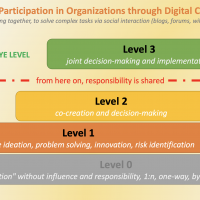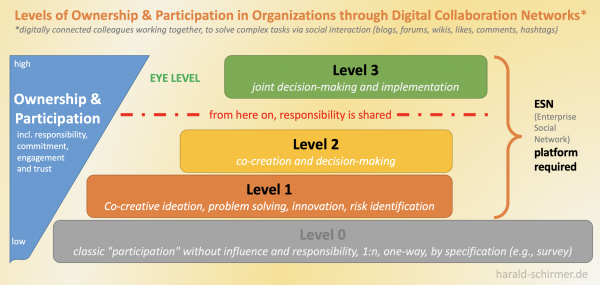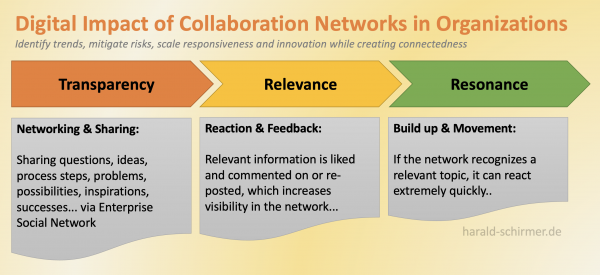
As dynamic and complexity rises in organizations, the management desire of employees taking over more responsibility, ownership or even intrapreneurship rises. It seems understood, that more brains – specially once they are collaboratively connected – can better:
- save money by avoiding double work and co-creation
- enhance quality due to their multi-perspectives
- reduce risks in early stages
- be more responsive on market or other shifts
- provide customer-centric insights (as they are customers)
- alert on emerging trends
- rise innovation power and creativity
- reduce resistance on transformation topics
- multiply adoption on sense-making changes
The big question – often connected to setting up new organizational forms (agile, network, community based…) – is how to sustainably drive this intrinsically motivated behavior in employees and leaders?
It just sounds so tempting to delegate a topic to a self-driven network or community. Many attempts to „build up such an active group“ has failed in the past years. Little participation, many questions and doubts on both sides and far away from a self-running system.
With this article I describe some relevant factors, which are needed to build up an engaged network or community and what is needed to be changed, in order to make this not just a one-time effort fading down quickly.
The following graphic shows four levels of participation – starting from todays most common situation.
To reach a higher ownership and participation, in general more transparency and „handing over responsibility“ is needed.
People just can not own a topic, for which they do not have enough information and freedom to design the process and outcome. Ownership rises with the level of trust and self-efficacy.
If one can not experience it‘s own impact, why shouldthey even try?
Think about it: Where do YOU invest in?
Let‘s take a look at the individual levels, I have experimented with and reached during my last decade of working with local and global networks. As with every model, while I tried to be specific, made it lacking the full diversity and options.
It is important to understand, that I cannot recommend (and even try to do a too fast approach) trying to over jump levels as this new „operating model“ (building trust takes time to build) takes some iterations, experiences and the creation of „stories being told“.
To start this transformation journey I would suggest to start with individual tasks, questions or for the target group relevant issues to build a digital reputation as leader. Once there are a decent amount of active followers/contributors, the next level could be a smaller project or initiative. After the involved (and observing!!) colleagues keep seeing, that this is being recognized in a positive way, bigger topics can be added. The bigger a persons digital reputation (and history), the faster one can start and the bigger a topic can be.
Going through the top 3 levels will engage employees from becoming followers with small contributions in level 1 to becoming digital leaders themselves in level 3.
Commitment rises with the level of influence
Commitment rises with the level of influence, investment and seeing results emerge. Ideally experienced together as a co-creating „tribe“ (network, community, group – depending on topic), as feedback, appreciation, feeling seen and having an impact fuels this system.

Level 0 – often the status quo
„Level 0“ seems to be todays most common situation in hierarchical organizations. I aim to illustrate this level in an extreme form to emphasize the harmful impact of this working style on people taking ownership and responsibililty.
At this level, participation is limited, with management primarily engaging in – often closed – one-way top-down communication or seeking „participation“ mainly through standardized surveys to gather quantitative feedback. Free-text is high effort and is tried to be avoided. Anonymus feedback very common (to „protect“ people) causing the problem that valuable feedback can not be followed up (to learn more).
Feedback in this level is often used to „just have reporting“ but not to change, improve or stop things with impact.
Employees lack sufficient information and are excluded from decision-making processes – a clear separation of strategy and operation by power and delegation (tayloristic approach).
Processes are optimized and controlled to reach a high level of predictability, stability and quality. Employees are seen as „resources“ and ideally behave like semi-programmable robots. In this paradigm, management positions itself as superior and prioritizes self-protection (e.g., by in-transparency), resulting in substantial individual alignment efforts.
Employees are often quoted as „not capable of understanding or carrying responsibility“.
The effect on employees of this negative management mindset is limited participation and vanishing loyalty.
As complexity in our business rises, management demands more ownership from people, while the above described behavior does not allow it:
- limited roles and responsibilities result in „This is not my job“ attitude
- strict, long budget processes result in „this is not planned, we have no budget for this“
- the more process are forced, the less likely humans are capable of performing (algorithms should be done by machines)
- requiring compliance* everywhere, results in reduced creativity and own thinking (*of course being compliant with law, but what about the thousands of internal rules, standards, guidelines, principles – hardly anyone is capable of even knowing them)
- too strong demand on focus, quality and efficiency results in „not helping others“ and silo structures where everyone takes care only of the own goals
- internal competition results in a information hiding, fear driven atmosphere
- in-transparency results in double work, miss-understandings, delays and alignment meeting marathons
- decision taking only by management results in micro-management and staff getting more and more „passive“
- missing self-efficacy by only “following“ procedures (feeling not being part of it) drives inner quitting
In a situation, where there is more work to be done than (qualified) people available, such a system is likely to collapse.
Level 1 – building trust by listening and respect
In level 1 management starts using the „collective intelligence“ to get answers on complex questions. The management places individual questions or tasks into the network asking for replies. The target group is asked to collect, provide and rate ideas, sources, risks, trends and feedback.
This can include:
- brainstorming
- input for problem solving
- supporting an innovation processes
- acting as early warning network for risks or
- to get multiple perspectives on fundamental questions.
A social tool (with profiles, network capabilities, likes and comments) is needed to process (collect, consolidate, identify relevance) such scalable results. The platform allows to visualize relevance and appreciation by the feedback of participants as well as offering powerful filters e.g. via tagging.
Trust builds up, once we feel someone is listening to us and respecting our input.
Trust is the essential fundament on which people leave their comfort zone.
„Publishing“ once opinion or feedback in a business context takes courage. Colleagues have to feel safe that their new behavior (speaking up) has no negative effect on them or their social reputation or career. (Depending on the organizations history and culture, this can be a longer process)
The challenge for the management is to ask concrete questions, for which they really want an answer AND being able to drive SHORT TERM action with the results of networks answers. If this this is delayed or not happening, or decisions seem disconnected to the answers, people will stop and go back to „work as told“
I tend to call this „Social Communication“ – the lowest level of Enterprise Social Network, as in this level participants just answer communicated questions.
This level already enhances the connection of employees to the company, as individuals can become visible and getting 360° – real time feedback for their engagement.
Level 2 – closing the gap while keeping mandates
Level 2 is about joint design and decision-preparation. The management shares more information earlier on and actively asks for and role-models participation – with the goal to initiate discussions and collaboration around the issue.
To show the relevance, empower participants and start building up ownership, management need to take part in role-modeling the process.
This is where employees more and more experience the manager as a digital leader.
The network* of the „willing“ or interested ones needs to be moderated and feeling integrated / part of the process. As people feel more heard, respected and involved, the result will be a more lively/rich exchange.
* (network size does not matter)
(Process) TRANSPARENCY can help (identify) RELEVANCE
which can foster (impactful) RESONANCE:

Now „Social Learning“ happens by sharing not only results, but giving insights to all steps of a process. This is a culture changing moment by actively learning from and with each other, creating a collaborative, appreciative solution and feedback culture.
At this level you need a „Social Collaboration“ platform, as „just talking“ and social exchange isn’t enough anymore. The network is actually working in ESN, so it needs collaborative tools like Blog, Wiki, Forum, Whiteboards, Kanban, Community features…
„We are part of it“ feeling connected
people begin to close the gap „us and them“ to a #WEwins
This stronger involvement of „many“ will lower resistance in change and transformation processes while again rising the collective engagement and satisfaction of people by creating a stronger sense of belonging.
Level 3 – shared responsibility levels intrapreneurship
What a dream: People assume full commitment to the organizations goals!
Level 3 is all about sharing responsibility and creates the highest level of ownership / intrapreneurship. It works according to the „eye level“ principle – through transparency and the gradual assumption of more and more responsibility in making! and implementing joint decisions.
As a huge benefit, by the individual commitment of many, the (shared) risks and resistance to change of all others significantly goes down:
the organization turns more agile, more resilient and changes from reaction-mode to dynamic, responsive design.
This level fully closes the gap between management and employees – which in the end will rise questions on career, salary and positions. If everyone carries the same risk and is part of the joint decision making, it is hard to explain, why one should earn more than others.
At the same time this would allow for more dynamic role changes without loosing social reputation, elected leadership, new – more suitable – career models, life-phase work models.
In this level, we can dramatically reduce the many „controlling“ tools, assessments, tests and processes of classical „miss-trust“ management.
One example is Continentals Manifest – a trust-agreement with the works council, instead of a detailed mis-trust-contract with many limitations. Since it’s establishment in 2019, no miss-use or escalation has been recorded.
Digital reputation and networks could replace big parts of the classical hierarchy inside an organization. But no fear for today’s management, as laws will most likely continue to requires clarity in structures for long. For management there is so much to win – once the willingness to this new organizational model grows.
Resume
In a nutshell: The results of such network based collaborative (transparency and participation) processes are:
- Rising participation and ownership of employees
- Risks are minimized through a collective early warning system
- Participation allows to use the swarm intelligence of connected brains
- Connects people to each other and the organization – „our tribe“ builds a sense of belonging
- Solving problems together and helping each other fosters strong personal bounds, building up trust and loyalty
- Life-long-learning – Learning from and with each other on the fundament of appreciation (without the effort on assessment, tests or other stress factors) creates the desire to „stay in the circle“
- Boosts the ability to generally innovate (multi-perspectives)
- Commitment is significantly higher when you implement things that you have influenced yourself
- Reaction speed to change increases
- Adaptability to dynamic situations increases – perfect for dealing with VUCA/BANI challenges
- Scalability means exponential implementation possibilities (movement: exponential effect) become possible
In a mature network organization, there is no need to „one-size-fits-all-top-down-roll-out“ a solution with hierachical power, managing and controling people.
Needed changes, innovative ideas or relevant actions, that just make (collective) sense are just being applied in a collective, appreciative movement. No classical control needed needed anymore, as it is clear, WHY things need to be done and where the network organization is heading.
The „HOW“ things are done in a network is based on collective values, sharing and constantly evolving formats and methods while „WHAT“ exactly is done lies decentralized in the individual decision. (with the full awareness of local culture, resources and opportunities)
„This will never work with our people“
… is nothing but the result of a „fixed mindset“. For sure the todays observations show many examples to prove this statement – as what we see, is the result of todays hierarchical mis-trust and dis-engaging structures, which have never been designed for todays world. The transformation of the organization is a management task and „they are not ready for this“ just points out, that we have not yet started to change this.
In my experience every human being is curious, there is a constantly growing desire to have a purpose and seeing personal impact in what we do. In all of us, there is the wish to be seen and as „social animals“, relationships and bonds are of vital importance – specially in a digital, hybrid environment.
It is unlikely that a network organization comes up with „one way or one solution only“
Creating options respects the diversity of complex tasks and networks. Celebrating those options, makes such an organization stronger and more resilient to the dynamic complexity out there.
To get a deeper insight on the building blocks on how networks grow, check out this post on LinkedIn: LINK

Schreibe einen Kommentar